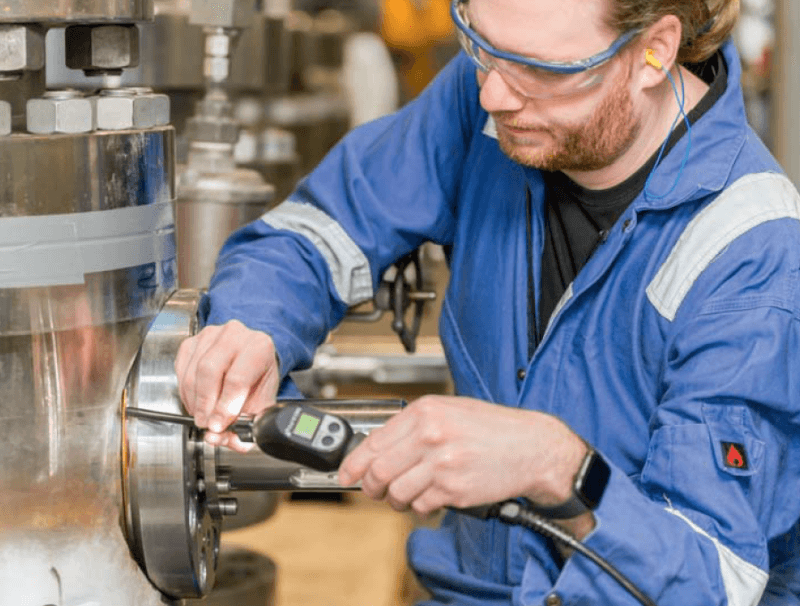Due to the energy transition the challenging media hydrogen will appear in additional application areas. To ensure safe operation, all components getting in contact with hydrogen must be qualified and absolutely tight. Reliable shut-off valves, the right material selection as well as standardised pressure tests help increasing operational safety in existing and new hydrogen application areas.
For many decades, the petrochemical industry is using special valves for hydrogen. With the energy transition accelerating, hydrogen will be found increasingly in other fields of application (see image below): from electricity generation (such as power-togas), through transport (in natural gas grids or hydrogen pipelines), to processing and mobility. The underground storage of hydrogen in salt caverns constitutes an environmentally friendly and safe solution for storing large amounts of energy to balance between power generation and demand. In all areas of application, the safe handling of hydrogen is paramount such that reliable shut-off valves are of particular significance.
Reliable shut-off valves
Hydrogen ball valves developed by experienced manufacturers, which are already being successfully deployed and whose hydrogen capability and the fulfilment of the highest leak-tightness requirements can now also be evidenced in test certificates, illustrate an important success and confidence factor in all hydrogen applications. Hartmann has developed durable, customized ball valves that are equipped with a metal-tometal seal between ball and seat ring. These are gas-tight, even at high pressures up to 690 bar.
Special designs for temperatures up to 550°C are available.
Also at high cycles up to 200,000 per year, ball valves offer a secure and reliable shut-off requiring little maintenance effort. Additional safety is provided by the Double Isolation and Bleed (DIB) option or the Twin Ball Valve (TBV) design – double ball valve with up to four barriers in one valve. Testing in the pipeline can be facilitated with the appropriate valve-work selection by means of the double block and bleed (DBB) function.
– story continues below the photo –

Secure interface
In the future, contemplated large-volume storage of hydrogen in caverns and wellheads form a secure interface between underground and above-ground plant. Hartmann wellheads are equipped as standard with pure metallic sealing ball valves to API 6A which in the standard form have a double seal against the bore pressure (DIB). Furthermore, doubled sealings at the flange connections as well as additional metallic sealings can be integrated at the wellhead. To reduce flange connections also a solid block design is possible, which integrates several components in one block.
Hydrogen application examples
In the Asiatic petrochemical industry, hydrogen ball valves have been deployed for a long time which also guarantee gas-tightness at extreme high temperature ranges. Hence Hartmann has supplied DN 200 PN 420 valves, for example, which are actuated at 184 bar and 380°C as well as DN 600 PN 420 ball valves which close securely at 191 bar and 426°C. One area of application within the scope of renewable energies where hydrogen is shut off, is electricity generation in the power-togas process. Hartmann special ball valves are deployed in the German Falkenhagen pilot plant constructed in 2013, amongst others. By means of electrolysis, up to 360 Nm3/h of hydrogen is manufactured here from electricity and water and fed into the natural gas grid. Besides hydrogen capability, an additional requirement on the shut-off valves was that they guarantee a high level of leak-tightness over a long operating period and should at the same time be as low-maintenance as possible. 24 specially developed ball valves (DN 25 and DN 50 up to PN 100) are being successfully deployed in the plant.
Standardised hydrogen tests
All components in direct contact with hydrogen must be suitable and tested leaktight as pressure vessel to guarantee safe operation. Hydrogen valves and wellheads must therefore meet the design criteria and metallurgy for a leak-tight and secure hydrogen application. We offer two hydrogen tests for both ball valves and wellheads as well as for the products of other manufacturers (based on documentation). By means of these expert tests, also for re-evaluating stock valves, the operational safety will increase, and
the complexity of in-house testing is also reduced. The proven hydrogen capability of the materials and the fulfilment of the highest leak-tightness requirements through standardised tests contribute to the future viability of a plant and long valvework idle times – even at high pressures.
– story continues below the image –

Material suitability tests
For all metallic components in direct contact with hydrogen, standardised material suitability tests are provided. Within the test scope the metallic material selection is evaluated regarding its resistance against hydrogen embrittlement to ensure that it is fit for hydrogen service. Molecular hydrogen H2 is comparatively stable and marginally reactive, therefore corrosion in the conventional sense is unlikely. So-called hydrogen embrittlement, i.e. hydrogen induced stress corrosion, presents a risk for highly stressed, ressurised components which requires particular consideration.
The test is performed on the basis of the following standards: Pressure Equipment Directive 2014/68/EU (DGRL), API 6A, API 6D, ASME, NACE MR175 / DIN EN ISO 15156. The following criteria are considered: hardness, surface hardness, ductility, heat treatment and structure.
Test for hydrogen leak-tightness
Being a small molecule, hydrogen can migrate through sealing elements. A comprehensive pressure test provides assurance that the threshold values are adhered to and fugitive emissions are minimised. The measurement of external leak-tightness is by means of mass spectrometer. As the test medium forming gas in accordance with DIN EN ISO 14175 is used. The leak-tightness is measured based on DIN EN ISO 15848. Thus, whilst complying with the safety requirements, tests can be carried out with the original hydrogen medium. The mixing in forming gas ensures that the lower explosion limit when then mixed with air cannot be reached. At the same time, the high level sensitivity of the mass spectrometer ensures that the mixture is in no way compromised in terms measurement accuracy. Thus even the smallest leakages in the ppm range can be reliably detected.
About the author
Dipl.-Ing. Werner Hartmann
Managing Director, Hartmann Valves
Further information: h2-ready.com


